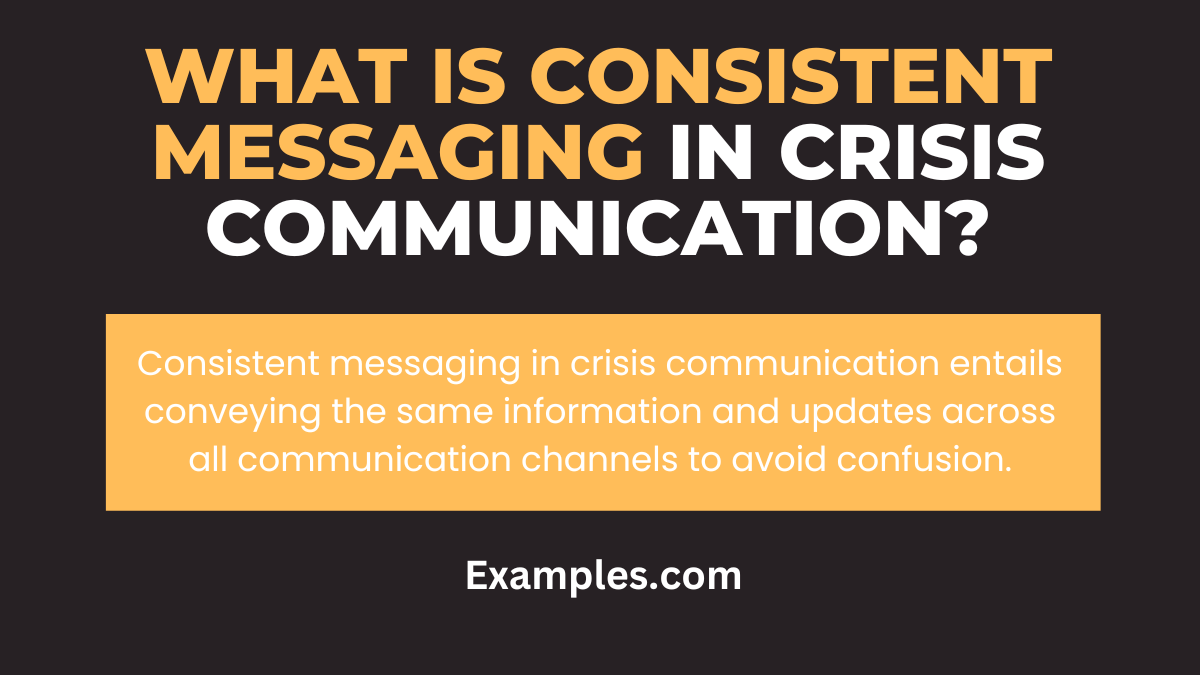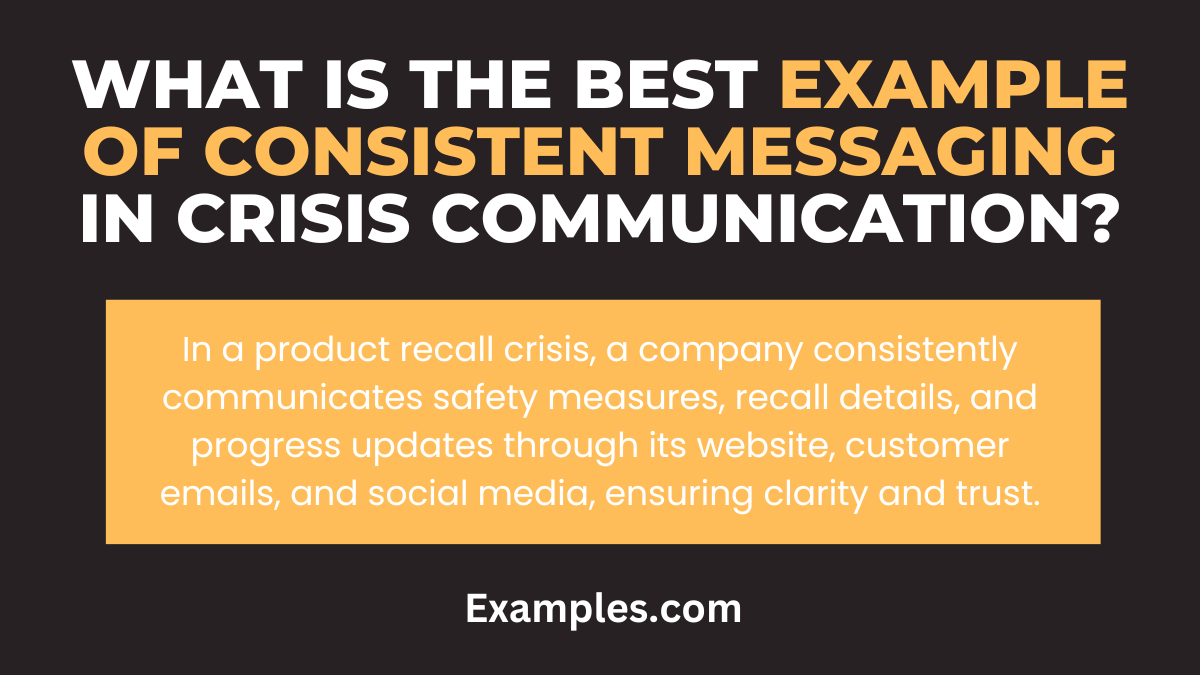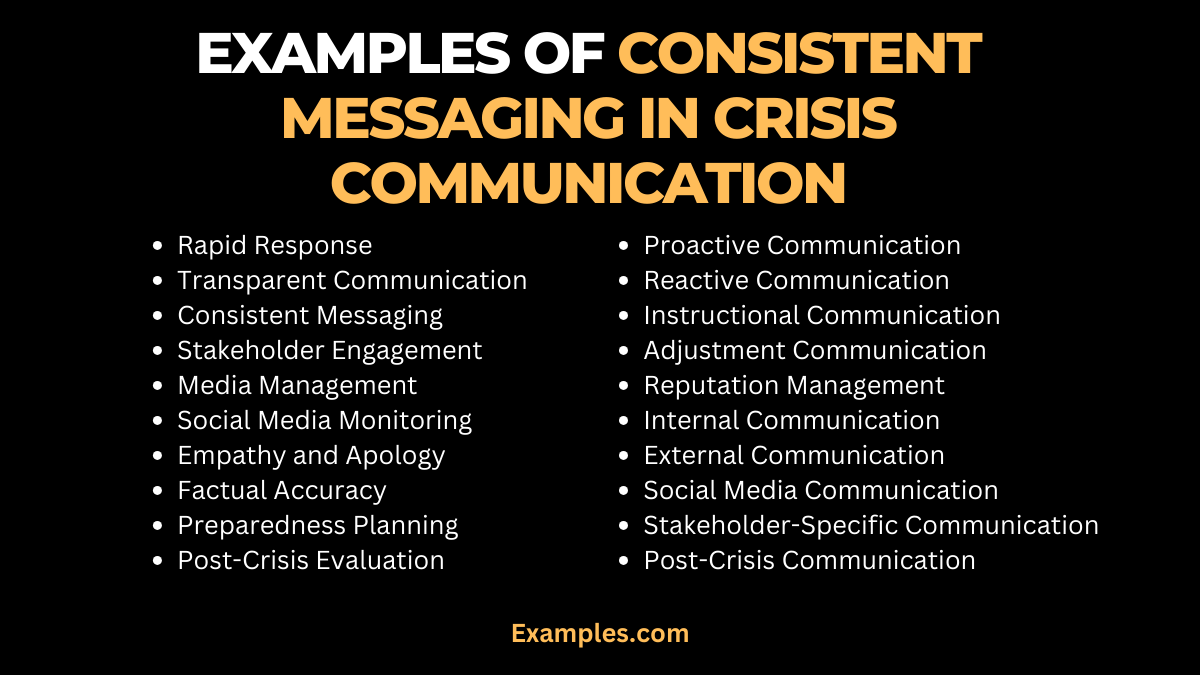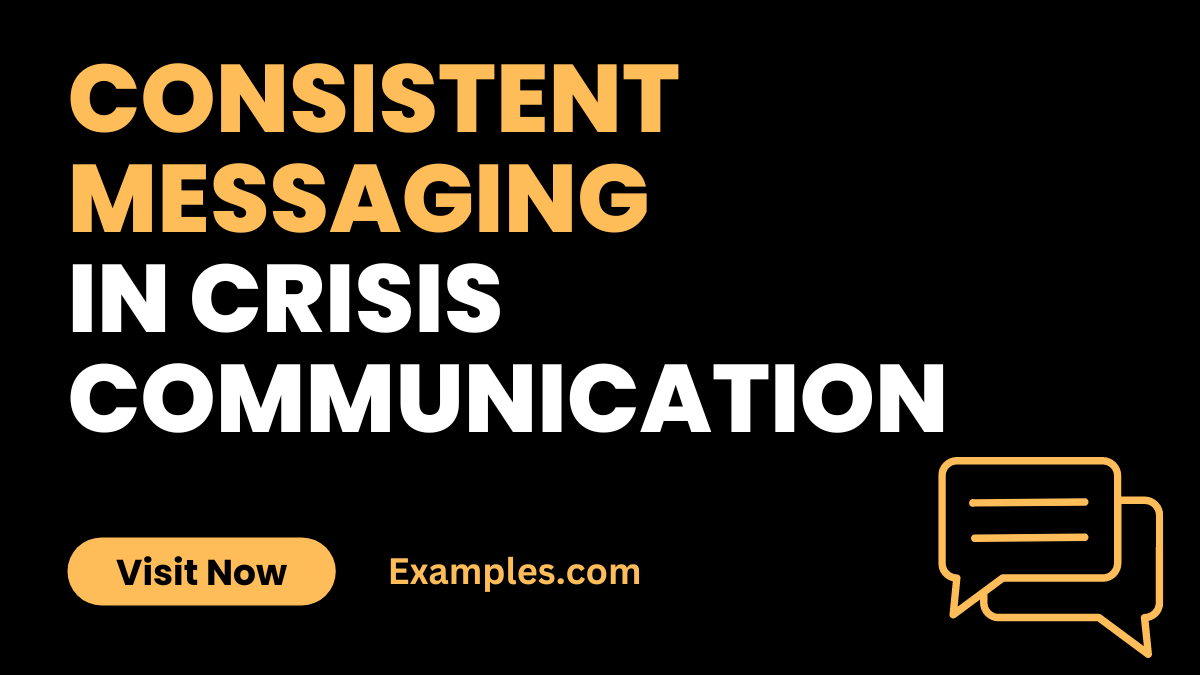19+ Consistent Messaging in Crisis Communication Examples
In the realm of crisis communication, the importance of consistent messaging cannot be overstated. This guide delves into the art of maintaining uniformity and clarity in messaging during turbulent times. It explores various strategies, illustrated with real-world examples, to ensure your communication remains consistent, thus fostering trust and stability among stakeholders. Discover how to effectively navigate through crises and uphold your organization’s reputation.
What is Consistent Messaging in Crisis Communication?

Consistent Messaging in Crisis Communication refers to the practice of delivering uniform and coherent messages during a crisis. It involves ensuring that all communications from an organization are aligned, both in terms of content and tone. This consistency is crucial as it helps to establish and maintain trust, provides clear and unambiguous information to stakeholders, and avoids confusion that can exacerbate the crisis. Effective consistent messaging requires a well-prepared strategy and a deep understanding of the crisis context.
Consistent messaging should be factual, transparent, and tailored to address the concerns of different stakeholder groups while maintaining a unified core message. It’s an integral part of crisis communication strategies, playing a pivotal role in managing perceptions and expectations during challenging times.
What is the Best Example of Consistent Messaging in Crisis Communication?

A notable example of consistent messaging in crisis communication can be seen in the handling of a product recall by a major corporation. In this scenario, the company discovered a flaw in one of its products that posed a safety risk. The response was swift and unified across all communication channels, including press releases, social media, and direct customer communications.
20 Examples of Consistent Messaging in Crisis Communication

In the realm of Crisis Communication, the efficacy of Consistent Messaging cannot be overstated. It ensures clarity, maintains trust, and steers the narrative positively during turbulent times. This article delves into 20 distinct examples, illustrating how strategic communication can effectively manage crises. Each example showcases a specific approach, underlining the Importance of Crisis Communication and its impact.
- Rapid Response: “We are aware of the situation and are taking immediate action.”
- Quick acknowledgment of the crisis shows readiness and control.
- Transparent Communication: “We commit to keeping you fully informed as we address this issue.”
- Promoting openness builds trust among stakeholders.
- Consistent Messaging: “Our priority remains the safety and well-being of everyone involved.”
- Reiterating core values emphasizes stability and concern.
- Stakeholder Engagement: “We invite our stakeholders to discuss the impact and our steps forward.”
- Involving key parties demonstrates inclusivity and responsibility.
- Media Management: “We will provide regular updates through official channels.”
- Controlling the narrative prevents misinformation.
- Social Media Monitoring: “We are listening to your concerns and will address them promptly.”
- Acknowledging public sentiment reflects attentiveness.
- Empathy and Apology: “We understand the impact of this crisis and sincerely apologize for any inconvenience caused.”
- Showing empathy and remorse can alleviate tension.
- Factual Accuracy: “Here are the verified facts regarding the current situation.”
- Disseminating accurate information combats rumors.
- Preparedness Planning: “Our crisis plan has been activated to ensure a coordinated response.”
- Demonstrating readiness instills confidence.
- Post-Crisis Evaluation: “We will review our response and make necessary improvements.”
- Commitment to learning and improvement post-crisis is crucial.
- Proactive Communication: “We are taking these steps to prevent potential issues.”
- Anticipating and addressing issues before they escalate shows foresight.
- Reactive Communication: “In response to this, we have implemented the following measures.”
- Adapting to situations swiftly indicates responsiveness.
- Instructional Communication: “Please follow these guidelines to ensure your safety.”
- Providing clear instructions aids in crisis management.
- Adjustment Communication: “Based on new information, we are updating our approach.”
- Flexibility in strategy demonstrates adaptability.
- Reputation Management: “We are committed to upholding our reputation for excellence.”
- Emphasizing ongoing commitment to values reinforces trust.
- Internal Communication: “All team members, please stay informed via our internal channels.”
- Ensuring internal stakeholders are informed maintains unity.
- External Communication: “To our customers, we assure you that we are handling this with utmost seriousness.”
- Addressing external stakeholders directly shows dedication.
- Social Media Communication: “We are using our platforms to keep everyone updated in real-time.”
- Leveraging social media for updates is efficient and widespread.
- Stakeholder-Specific Communication: “To our investors, here is how we are mitigating risks.”
- Tailoring messages to specific groups ensures relevance.
- Post-Crisis Communication: “Following the crisis, here is our plan for moving forward.”
- Outlining future steps post-crisis provides direction and closure.
Importance of Consistent Messaging in Crisis Communication
- Builds Trust and Credibility: Consistent messaging in crisis communication ensures that all stakeholders receive the same information, which helps build trust and credibility with the audience.
- Prevents Misinformation: Inconsistencies can lead to confusion and misinformation. Consistent messaging helps ensure that accurate information is disseminated.
- Enhances Message Retention: Repetition of a consistent message increases the likelihood that your audience will remember and understand the key points.
- Facilitates Clear Decision-Making: During a crisis, clear and consistent messages help stakeholders make informed decisions quickly.
- Supports Brand Image: Consistent messaging protects and supports the organization’s brand image, even in challenging times.
- Aligns Internal and External Communication: Ensuring that both internal and external communications are aligned prevents mixed messages and confusion among different audiences.
- Helps in Crisis Management: Effective crisis management relies on consistent messaging to guide the narrative and manage the situation effectively.
- Prepares for Post-Crisis Recovery: A consistent communication approach lays the groundwork for a smoother post-crisis recovery and future communication strategies.
Tips for Crafting Effective Key Messages in Crisis Communication
- Identify Core Messages: Start by identifying the core messages that need to be communicated to your audience during the crisis.
- Keep It Simple and Clear: Key messages should be simple, clear, and free of jargon to ensure they are easily understood by all stakeholders.
- Be Accurate and Truthful: Ensure that all key messages are accurate and truthful to maintain credibility and trust.
- Show Empathy and Concern: Demonstrating empathy and concern in your messages can help in building a connection with your audience.
- Tailor Messages to Different Audiences: Customize your key messages for different stakeholder groups to ensure relevancy and effectiveness.
- Incorporate Actionable Steps: Provide clear, actionable steps or instructions in your messages to guide the audience during the crisis.
- Reinforce with Supporting Facts: Back up your key messages with supporting facts and data to enhance their credibility.
- Regularly Update and Adapt: Be prepared to update and adapt your key messages as the situation evolves to maintain their effectiveness.
In mastering Crisis Communication, a crucial aspect is ensuring consistent messaging. This involves delivering uniform information across all channels, maintaining transparency, and upholding the trust of stakeholders. Consistent messaging helps in mitigating confusion and misinformation, especially during critical moments. Emphasizing accuracy and empathy, it forms the backbone of effective crisis management strategies, playing a pivotal role in maintaining an organization’s integrity and public perception. Remember, in crisis communication, clarity and consistency are not just best practices, but necessities.



